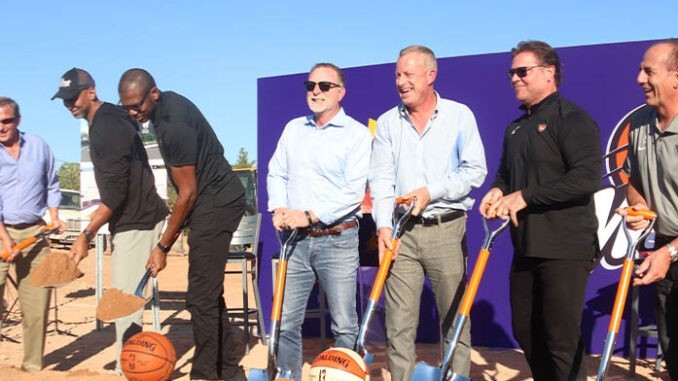
PHOENIX – Phoenix Suns owner Robert Sarver is investing heavily in his team, emotionally and literally.
Standing with General Manager James Jones, coach Monty Williams and other officials, Sarver officially broke ground on the team’s new state-of-the-art training facility last week. The ceremony took place amid a surprising start by the Suns, who took a 7-4 record into Monday night’s game against the Boston Celtics.
“We do have a lot of good momentum, both on and off the court,” Sarver said. “I think we have a really good foundation. When I look at the communication triangle with myself and James and Monty, and then I look at the players we have and the combination of youth and veterans, I think we have something we can keep running for a long time.”
The $45-million practice facility, which is being privately funded by the Suns, is a big part of that long-term plan.
The Suns had fallen behind the curve with a practice court inside Talking Stick Resort Arena rather than having a dedicated practice and training facility for the Suns and WNBA Phoenix Mercury. Of the 15 teams in the NBA’s Western Conference, only Phoenix, Houston and Denver remain without separate training facilities.
For Sarver, the project isn’t just about keeping up with the competition, it’s about building a foundation for the Suns to flourish after a long stretch of futility. The Suns haven’t reached the playoffs since 2010.
The facility, located just north of 44th Street and Camelback Road, is part of a deal the team made with the city for a $230-million renovation of the arena, which was approved by the Phoenix City Council in January. That agreement includes $150 million from the city’s Sports Facilities Fund and $80 million, plus any budget overrides, from the Suns.
The renovation project requires repurposing the current practice court space, so as part of the deal, the Suns agreed to finance the construction of an off-site practice facility that would be located within Phoenix city limits.
Sarver personally picked the location because of its proximity to the downtown arena, Phoenix Sky Harbor International Airport and Scottsdale. Sarver agreed to the location within 15 minutes of meeting with RED Development Managing Partner Mike Ebert, who said the facility is part of the first phase in a $300-million, mixed-use development of the area.
The Suns will share the building with the Mercury, with players from both teams having year-round access to the complex. As one of five NBA franchises that still owns and supports a WNBA team, Sarver hopes to create a championship contender with the Suns and continue the winning culture of the Mercury, who will play next season at Veterans Memorial Coliseum while Talking Stick Resort Arena is renovated.
Ground is officially broken on the #Suns’ new practice facility here at Camelback and 44th in #Phoenix! @sportscronkite #RisePHX pic.twitter.com/4OJAhV5bOo
— Dylan Hunter Carter (@DylanHCarter) November 13, 2019
Among the facility’s planned features is technology that will allow players and staff to enter the building around the clock.
“We want our players to have access to this facility, use it as much as possible,” Sarver said. “So they will each have 24/7 access with retinal scan. They’ll be able to get into the building anytime they want to work out or get up shots.”
In a news release from the Suns, Jones said the training center will “serve as a sanctuary for our players” that will foster their development on and off the court.
“We talk often about building championship habits here in Phoenix and today is a big step towards creating an atmosphere where our players can compete and thrive at the highest level,” Jones said in the statement.
As a player, Jones won two titles with the Miami Heat and one with the Cleveland Cavaliers. As an interim general manager last season, Jones upgraded the Suns roster with trades for forward Kelly Oubre Jr. and guard Tyler Johnson. Then after having the interim tag removed, he continued the makeover by signing point guard Ricky Rubio and forward Frank Kaminsky, trading for forward Dario Saric and center Aron Baynes and drafting forward Cameron Johnson and point guard Ty Jerome.
The results have been dramatic.
“We demand a lot from our players and from our staff,” Jones said. “We set high expectations, and with that comes a great responsibility from us to make sure that we provide them with the best in class: the world’s best facilities, resources and opportunities to develop and grow.”
Phoenix City Councilman Sal DiCiccio, who serves District 6 and was one of two council members who voted against the arena renovation proposal, believes the new project will benefit the Arcadia area, which is in his district.
“The Suns and Mercury organizations are dedicated to putting a world-class product on the court, a commitment that extends throughout their operations,” DiCiccio said. “This is a tremendous investment in our community, and I couldn’t be happier to welcome our new neighbors to Arcadia.”
Although most other teams already had similar facilities in place, the Suns intend to make this one of the best facilities in professional sports. In addition to practice courts, medical and athletic training facilities, plans include expansive player lounges, views of Camelback Mountain, natural sunlight in each room and expertly-designed recovery rooms.
The facility is scheduled to open Aug. 1, 2020, before the Suns open training camp for next season.
